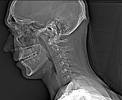
Dense Plasma Focus
Resources
This page is a little more informal and free-form than most since it is just a copy of my notes.
This particular type of dense plasma focus is an electrical discharge between coaxial electrodes in weak vacuum (the dense part) of about 12 torr. The electrical current sheath in the plasma between the coaxial electrodes experiences the lorentz force (like a railgun) which accelerates the plasma towards the end of the device (inner electrode is anode, outer tube is cathode/ground). When the sheath reaches the end of the electrodes the lines of magnetic force undergo a pinch wherein the field is greatly concentrated in a small volume due to instabilities (youtube video cgi example). The combination of the electrical current flow (a kiloamp discharge) and the intense magnetic field gradient trapping (as well as heating) causes the plasma's constiuents' temperatures to rise. It turns out the scaling laws for the maximum temperature possible make an extremely low energy discharge (0.25J) able to achieve the same plasma temperatures, and current sheath velocities, as very large megajoule discharges. The volume and mass of matter is much smaller of course. And in large machines of hundreds of thousands of kiloamperes the magnetic field is said to get high enough to create differences in temperatures between the light electrons and heavier ions. These larger machines and the effects of their extremely high magnetic fields are being investigated for fusing predisposed isotopes of hydrogen. I want to make a tiny one to use with non-fusing noble gas just for fun.
Two impractical sketches of miniature DPF

In the first set of sketches the surface area of plastic exposed in this structure would make outgassing difficult to handle and the glass jar would be inappropriate for situations involving electron beams. Instead a closed, thick, silver soldered and epoxied galvanized iron tube of some thickness will be used. This design is okay for testing and debugging of electronics at low voltages and high pressures.
In the second set of sketches the design would probably require different layout for the path of bus bars and bottom ground. I think it would be too much inductance in the 4 paths and the joints might be of too high resistance. The effect of the bottom ground plate of aluminum might impact the discharge speed of the central brass disc capacitor adversely due to induction.
Unsorted notes, contains errors
There are two NF DPF devices by Soto. Low pressure big anode, high pressure small anode. The later is better. 0.00025 J, 0.021 cm radius anode (0.042 cm diameter (0.42mm)), 6kA peak current (?undamped?), 12 tor (16 mbar), 70(kA mbar^−1/2 cm^−1), Energy/volume anode*pressure 16.9*10^7 (J / m^3 mbar)
0.42mm diameter copper wire anode
In addition, evidence of neutron emission has been observed in the ultraminiature device Nanofocus operating at 0.1 J of stored energy and 20 Hz of repetition rate. However, the reproducibility of this miniature device is low and several technological subjects have to be previously solved in order to produce neutrons for periods greater than minutes. Due to the low reproducibility of the Nanofocus and the fact that the device has not yet been optimized, the data of its neutron yield were not included in the plot. The same method was used to characterize the x-ray emission from the Nanofocus device operating at 0.1 J. Radiographs of an array of aluminum filters of 30, 45 and 60 μm on a HP5 Ilford film were obtained by integrating 1200 shots on the film. In this case, an effective mean energy of 4.3 ± 0.3 keV was obtained
GOOD. No neutrons wanted; can't shield them. 5kV xrays? Too much, if any, probably. But if there are no holes in the devices in thick pipe then nothing would get out. But computer monitors can accelerate up to 20keV so their internal brightness is more. Cathode ray tubes aren't regulated. Still need to know exact laws. Can DPF be done in higher pressures with altered geometry to get practice? No xrays, just lots of ionization. Slows the pulse requirements, can have more external inductance and still match impedance of pinch.
Run the dense plasma focus at the temperature of the chromosphere with the same constituent gases. Compare the vacuum spectra by diffraction grating, or even just two pinholes. The precision of the distance between them wouldn't have to be perfect if the relative fringe lengths could be fit. The magnetic field intensity would be much higher than the sun, and the plasma density... higher? Have to compare the beta of dense plasma focus and solar chromosphere. Doesn't need to be an extremely high temperature, no fusion needed. Just a bright light like the sun. There should be minimal radiation. But some soft xray? So, look up the regulations. Consult the university before anything.
a silicon pin diode with removed glass window and aluminium filter should detect the soft x-rays.
NON-Porous High-Alumina Ceramic Tube .156" OD, .094" ID, 12" Length
16 ns to get to peak current of 100 amps. Slightly underdamped. full ~30-40 ns full width. 5 nanofarad cap, inductance of 5 nanoHenry.
Cu anode radius partially covered by an insulator
It has been shown that the size of the plasma pinch column scales linearly with the anode radius a.
The pinch radius is ∼ 0.12a, and the pinch length is ∼ 0.8a
the bright spots have typical dimensions lower than 0.1 times the pinch diameter, i.e., less than ∼ 0.024a.
the electron beam diameter is on the order of the pinch diameter, i.e., 0.24a;
source size of soft X-rays is on the order of ∼ 0.024a or less, and for the hard X-rays, it is on the order of ∼ 0.24a.
anode radius a scales with the stored energy of the device E as a^3 α E (anode radius cubed proportional to energy)
instantiation: 4.9 nF copper disk, 4.8 nH, ∼5–10 kV, ∼5–10 kA, 60–250 mJ, and 16-ns time to peak current
(7.73*10^-5)*(peak current in kA)^4.82
Submillimetric anode radii (0.8 and 0.21 mm) covered by coaxial insulators were used for experiments in hydrogen. discharges operating at 3 mbar and ∼100 mJ.
0.022 cm radius * 2 = 0.044 cm diameter, 0.42 to 0.44 mm diameter.
1 cm long insulator column on 1.6 mm Coper tube covered with alumina. 0.022 cm radius (0.044 cm diameter) anode column. 0.04 cm (0.4mm) long anode projection above insulator column. Note that the anode projection from insulator is approximately equal to anode diameter.
In order to prevent spark-over through the coaxial hole in the dielectric a very small alumina covering is required. Tubes are too big and lose. An alumina coating on the copper wire is required. Alumina potting compounds which cure at conventional oven temperatures are available for a moderate price Cast-Coat in.'s CC3-343 mix seems well suited.
25 cm × 25 cm × 5 cm size.
pair of 200 mm diameter brass capacitor plates (http://www.onlinemetals.com/merchant.cfm?pid=20311&step=4&showunits=inches&id=1118&top_cat=87 )
(online metals: 12"x12"x0.0625" or 305mm*305mm*1.6mm )
separated by 0.32mm and 4 layers of 80 micron (.003 inch) PVDF (Polyvinylidene Fluoride) film available at McMastercar.
Alternately cshyde sells for about the same price.
$14 for 1ft*2ft of 76.2 micrometers thick PVDF film (76.2*4 layers = 305 micrometers)
http://catalog.cshyde.com/item/films/pvdf-kynar-film-polyvinylidene-fluoride/pvdf-32-5f-24?
$45 for 1ft*2ft of 381 micrometers thick PVDF film (381*1 = 381 micrometers)
http://catalog.cshyde.com/item/films/pvdf-kynar-film-polyvinylidene-fluoride/pvdf-32-15f-24?
A parallel plate capacitor of 20cm diameter has a coaxial hole for an alumina coated wire of 0.5mm diameter to bring a wire from the bottom plate 1cm up above the top plate. As a dielectric there are 4 layers of 80 (76.4) micron PVDF film, this too with a coaxial hole for the alumina coated wire.
Bell jar: 15 cm OD, 14 cm ID, 1cm thickness at base. 18 cm tall
4cm diameter pipe.
Put the vacuum O-ring seals in between the plastic cover plates and and the 5nF capacitor plates!
What's really important, beyond the PVDF dielectric strength issue, is what are the specifications of the spark cap and the resistance of the chamber discharges. Are rounded balls used? What distance are they apart?
For high pressure 10^-5 mbar: The most serious hazard in the early applications of vacuum insulation was the presence of excessive residual gas, which manifested itself either directly as a relatively high ambient pressure in the gap, probably little better than --10^-6-10^-5 mbar, or indirectly as transient pressure bursts caused by the thermal desorption of gas from the electrodes and vacuum chamber walls by localised electron or ion bombardment processes.
Surround dense plasma focus pinch with RETGEM. 6 panels, strip anode readout for each. What's the best arrangement of strip orientations for each side to enable imaging in high resolution? A given set of opposing parallel sides of the box should have their anode readout strips perpendicular to each other. So all three sets of two opposing panels each contain members that are rotated 90 degrees to each other.
12 torr (16 mbar) pressure
0.21 Joules =~ 0.5*(5 nF)(9 kV)^2
4.9nF @ 9kV, 1.2Ohm, 4.8nH = 19.2 nanosecond pulse peak of 4.5kA @ 8ns?
charging resistance 100 M
primary capacitor 28 nF
A pair of 200 mm diameter brass electrodes act as a capacitor to drive the discharge. A 1.6 mm Cooper tube covered with alumina is attached to the center of the anode plate and passes through a small hole in the cathode center. Four dielectric PVDF films, 80 μm thick, were placed between both plates. The measured capacity is 4.9 nF. The total dimensions of the device are 20 cm×20 cm×5 cm. A primary capacitor of 28 nF charges the driven capacitor by means of a pulse.
http://www.jarrodkinsey.org/co2laser/co2laser.html - use construction techniques from here for making the central capacitor/insulator/anode vaccum tight interface (technique orginally suggested in the CO2 laser plans from Information Unlimited).
[comment on this post] Append "/@say/your message here" to the URL in the location bar and hit enter.


